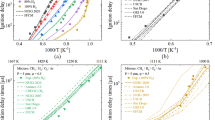Abstract
A general model describing the combustion of mixed gases is proposed, which accounts for the chemical work and assumes a single chemical reaction. An energy equation is written for an arbitrary mixture of fuel/oxidizer/combustion product. The combustion of an H2/O2 mixture is considered on the basis of the model. Modeling is carried out for two options: with and without account for the dependence of the heat capacity of the mixture components H2, O2, and H2O on temperature. The chemical work has a positive sign, and its relative contribution to the main characteristics of the process (temperature and burning rate) is estimated at 3.9 and 19%.




Similar content being viewed by others
REFERENCES
K. A. Putilov, Thermodynamics (Nauka, Moscow, 1971) [in Russian].
K. O. Sabdenov, “Effect of Molar Mass Variation on a Flame Temperature and a Burning Rate," Fiz. Goreniya Vzryva57 (1), 51–57 (2021) [Combust., Expl., Shock Waves57 (1), 46–52 (2021); DOI: 10.1134/S0010508221010056].
G. B. Manelis, Thermal Decomposition and Combustion of Explosives and Propellants (CRC Press, London, 2003).
N. Kubota, Propellant and Explosives: Thermochemical Aspects of Combustion (Wiley-VCH Verlag GmbH & Co. KGaA, Veinheim, Germany, 2002).
V. K. Bulgakov, V. I. Kodolov, and A. M. Lipanov,Simulation of Combustion of Polymer Materials(Khimiya, Moscow, 1990) [in Russian].
J. Li, H. Huang, and N. Kobayashi, “Hydrogen Combustion As a Thermal Source," Energy Procedia 142, 1083–1088 (2017).
J. Alazemi and J. Andrews, “Automotive Hydrogen Fuelling Stations: An International Review," Renewab. Sustain. Energy Rev.48, 483–499 (2015).
J. Sosa, R. Burke, K. A. Ahmed, et al., “Experimental Evidence of H2/O2 Propellants Powered Rotating Detonation Waves," Combust. Flame 214, 136–138 (2020).
L. K. Gusachenko and V. E. Zarko, “Combustion Models for Energetic Materials with Completely Gaseous Reaction Products," Fiz. Goreniya Vzryva 41 (1), 24–40 (2005) [Combust., Expl., Shock Waves 41 (1), 20–34 (2005)].
A. L. Sánchez and F. A. Williams, “Recent Advances in Understanding of Flammability Characteristics of Hydrogen (Review)," Prog. Energy Combust. Sci. 41, 1–55 (2014).
H. C. Lee, L. Y. Jiang, and A. A. Mohamad, “A Review on the Laminar Flame Speed and Ignition Delay Time of Syngas Mixtures (Review)," Int. J. Hydrogen Energy 39, 1105–1121 (2014).
D. B. Spalding, Combustion and Mass Transfer(Pergamon Press, Oxford–New York, 1979).
Ya B. Zeldovich, G. I. Barenblatt, V. B. Librovich, and G. M. Makhviladze, The Mathematical Theory of Combustion and Explosions (Plenum, New York, 1985).
V. A. Kudinov, Engineering Thermodynamics(Vysshaya Shkola, Moscow, 2000) [in Russian]
N. N. Kalitkin, Numerical Methods (Nauka, Moscow, 1978) [in Russian].
B. E. Gel’fand, O. E. Popov, and B. B. Chaivanov, Hydrogen: Combustion and Explosion Parameters (Fizmatlit, Moscow, 2008) [in Russian].
V. M. Zubanov, D. V. Stepanov, and L. S. Shabliy, “The Technique for Simulation of Transient Combustion Processes in the Rocket Engine Operating with Gaseous Fuel ‘Hydrogen and Oxygen’," Vestn. Samar. Univ. Aerokosm. Tekh., Tekhnol. Mashinostr. 15 (4), 64–74 (2016) [J. Phys.: Conf. Ser. 803, 012187 (2017)].
J. Shao, R. Choudhary, A. Susa, et al., “Shock Tube Study of the Rate Constant for H + O2 + M \(\to\) HO2 + M (M = Ar, H2O, CO2, N2 at Elevated Pressures," Proc. Combust. Inst. 37, 145–152 (2019).
R. Choudhary, J. J. Girard, Y. Peng, et al., “Measurement of the Reaction Rate of H + O2 + M \(\to\) HO2 + M, for M = Ar, N2, CO2, at High Temperature with a Sensitive OH Absorption Diagnostic," Combust. Flame 203, 265–278 (2019).
X. Yang, W. Liang, T. Tan, and Ch. K. Law, “Reevaluation of the Reaction Rate of H + O2 (+M) = HO2 (+M) at Elevated Pressures," Combust. Flame 217, 103–112 (2020).
N. B. Vargaftik, Tables on the Thermophysical Properties of Liquids and Gases: In Normal and Dissociated States (Nauka, Moscow, 1972; Hemisphere, 1975).
Short Manual for Chemists, Ed. by B. P. Nikol’skii (Khimiya, Moscow–Leningrad, 1982).
K. O. Sabdenov, “Diffusion-Thermal Instability of a Laminar Flame," Inzh.-Fiz. Zh. 75 (4), 73–79 (2002) [J. Eng. Phys. Thermophys. 75 (4), 859–867 (2002)].
E. R. Shrager, I. M. Vasenin, and K. O. Sabdenov, “Comparative Analysis of the Results of Solving the Problem of the Diffusive-Thermal Instability of Flames," Izv. Tomsk. Politekh. Univ. 308 (6), 28–33 (2005).
T. T. Aung and S. Kadowaki, “The Effects of Unburned-Gas Temperature and Heat Loss on the Diffusive-Thermal Instability of Premixed Flames," J. Therm. Scient. Technol. 8 (1), 323–335 (2013).
S. Kadowaki, M. Yahata, and H. Kobayashi, “Effects of the Unburned-Gas Temperature and Lewis Number on the Intrinsic Instability of High-Temperature Premixed Flames," J. Therm. Scient. Technol.6 (3), 376–390 (2011).
R. Edse and L. R. Lawrence, “Detonation Induction Phenomena and Flame Propagation Rates in Low Temperature Hydrogen–Oxygen Mixtures," Combust. Flame 13, 479–486 (1969).
K. O. Sabdenov and M. Erzada, “Anomalous Effect of Turbulence on the Combustion Rate of a High-Energy Solid Material," Khim. Fiz.37 (10), 51–59 (2018) [Russian J. Phys. Chem. B12, 890–898 (2018)].
G. Nicolis and I. Prigogine, Self-Organization in Nonequilibrium Systems: From Dissipative Structures to Order through Fluctuations (Wiley, 1977).
Author information
Authors and Affiliations
Corresponding author
Additional information
Translated from Fizika Goreniya i Vzryva, 2021, Vol. 57, No. 2, pp. 48–59.https://doi.org/10.15372/FGV20210205.
Rights and permissions
About this article
Cite this article
Sabdenov, K.O. Effect of Chemical Work on the Flame Temperature and Burning Rate of an H2/O2Mixture. Combust Explos Shock Waves 57, 171–181 (2021). https://doi.org/10.1134/S0010508221020052
Received:
Published:
Issue Date:
DOI: https://doi.org/10.1134/S0010508221020052




